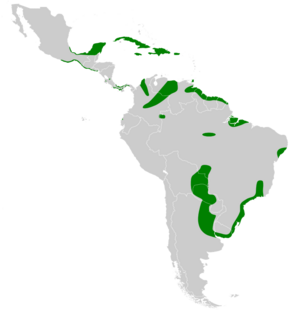Yellow-breasted crake facts for kids
Quick facts for kids Yellow-breasted crake |
|
|---|---|
 |
|
| at Arari, Maranhão, Brazil | |
| Conservation status | |
| Scientific classification | |
| Genus: |
Laterallus
|
| Species: |
flaviventer
|
 |
|
| Synonyms | |
|
Micropygia flaviventer (Boddaert, 1783) |
|
The yellow-breasted crake (Laterallus flaviventer) is a small bird that belongs to the Rallidae family. This family includes birds like rails, gallinules, and coots. You can find this bird on several islands in the Caribbean. It also lives in most parts of Central America and South America.
Contents
About the Yellow-Breasted Crake's Name
Scientists give every animal a special two-part name, like Laterallus flaviventer for the yellow-breasted crake. This helps everyone know exactly which animal they are talking about.
Sometimes, scientists disagree on the best way to group animals. This means the yellow-breasted crake's scientific name has changed over time. It was once placed in a group called Porzana. Now, many scientists agree it belongs in the group Laterallus. However, some still think it should be in its own group called Hapalocrex.
Scientists have also found five slightly different types, or subspecies, of the yellow-breasted crake:
- L. f. gossii
- L. f. hendersoni
- L. f. woodi
- L. f. bangsi
- L. f. flaviventer
What Does the Yellow-Breasted Crake Look Like?
The yellow-breasted crake is a small bird, about 12.5 to 14 centimeters (5 to 5.5 inches) long. Males usually weigh between 22 to 29 grams (0.8 to 1 ounce). Females are a little lighter, weighing 20 to 28 grams (0.7 to 1 ounce). Both male and female birds look very similar.
Their face is a buffy color. They have a dark line that goes through their eye. Above this line, there is a pale, buff-white stripe. This face pattern is special and helps tell them apart from other similar birds in the Americas.
The main type of yellow-breasted crake, called L. f. flaviventer, has brown feathers on its upper body. Its throat is white, and its chest is a buffy yellow. The sides of its body and its belly have black and white stripes. The other subspecies are a bit different in size and how bright their colors are. For example, L. f. gossii and L. f. flaviventer are the largest. The L. f. flaviventer also has the darkest neck and chest.
Where Do Yellow-Breasted Crakes Live?
The five subspecies of yellow-breasted crake live in different areas:
- L. f. gossii lives in Cuba and Jamaica.
- L. f. hendersoni lives in Hispaniola and Puerto Rico.
- L. f. woodi lives from central Mexico down to northwestern Costa Rica.
- L. f. bangsi lives in northern Colombia.
- L. f. flaviventer lives in Panama, northern and central Colombia, Venezuela, and the Guianas. It also lives in parts of Brazil, eastern Bolivia, Paraguay, and Uruguay, reaching into northeastern Argentina. You can also find it in Trinidad and Tobago.
These birds mostly live near fresh water, like marshes and the grassy edges of ponds and lakes. They also like rice fields and flooded grassy areas. You can find them from sea level up to about 2,500 meters (8,200 feet) high.
Yellow-Breasted Crake Behavior
How Yellow-Breasted Crakes Move Around
Yellow-breasted crakes usually stay in one place. However, they might move locally when water levels change. For example, in Costa Rica, they seem to move around depending on how much water is in their habitat. Some scientists think they might even migrate a bit in certain areas.
What Yellow-Breasted Crakes Eat
These crakes look for food among plants that grow in the water. They sometimes run across these plants or climb on them. They often come out from cover at dawn and dusk to feed right at the water's edge. Their diet includes small snails, insects, and seeds.
Yellow-Breasted Crake Reproduction
We don't know all the details about when yellow-breasted crakes breed. It seems to depend on where they live. They build a loose nest using reeds or marsh grass. A female crake usually lays about four eggs. Scientists are still learning more about how these birds raise their young.
Yellow-Breasted Crake Sounds
The yellow-breasted crake makes at least three different sounds. One is a low, harsh, rolling sound like "k'kuk kurr-kurr." Another is a sad, squealing sound, either a single "kreer" or "krreh," or repeated. They also make a high-pitched, whistling "peep" sound.
Yellow-Breasted Crake Status
The IUCN (International Union for Conservation of Nature) has listed the yellow-breasted crake as a species of "Least Concern." This means they are not currently in danger of disappearing. Scientists estimate there are about 7,000 adult birds, but they don't know if this number is going up or down. No big threats have been found for them right now. They are thought to be common in many places they live, and they might even be more widespread than we currently know.


